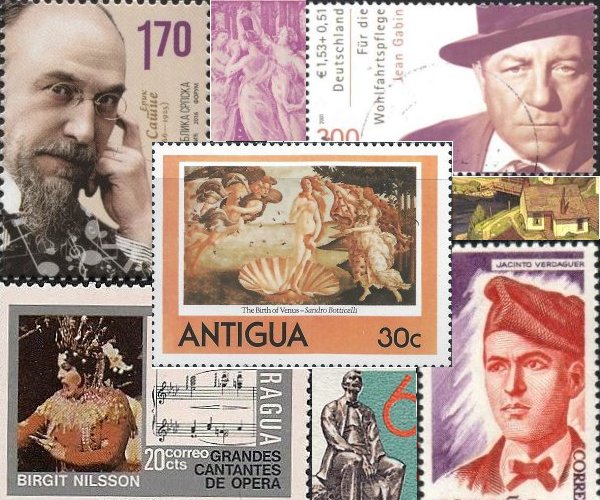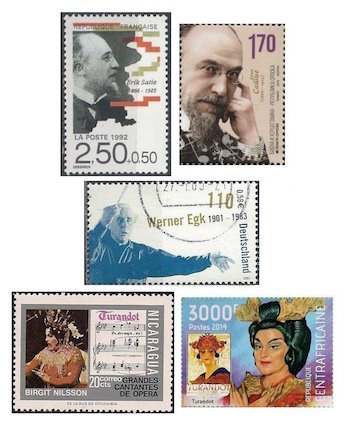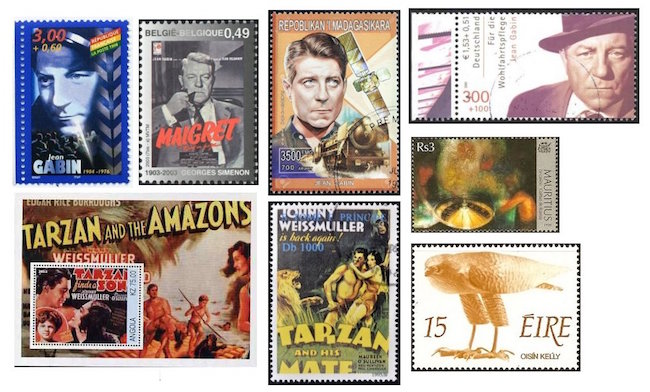The Arts on the Stamps of the World — May 17
An Arts Fuse regular feature: the arts on stamps of the world.

By Doug Briscoe
Today’s stars are Botticelli, Erik Satie, and Birgit Nilsson, but we have plenty more in store.

As you no doubt can predict, especially if you’ve seen our spreads on Michelangelo, Raphael, and the like, Botticelli is much presented on stamps of the world. The United States alone has chosen Botticelli’s work for three of its Christmas issues (1981, 1988, and 2008); much earlier, somebody selected the Three Graces from La Primavera (c1482) to illustrate the stamp for the 50th anniversary of the Pan-American Union in 1940. The same beloved painting was chosen for a lovely trio of San Marino stamps in 1972. The Italian stamp gives us what may be a self-portrait, taken from the master’s Adoration of the Magi (1475). This work can be seen, albeit not very well in this image (so click on this link if desired), on a 1968 Christmas stamp from Grenada. Of course, another great favorite is The Birth of Venus (1486), as seen in examples from Antigua and France. In the bottom row we see Portrait of a Young Man (c1482-85) on a stamp from Burundi, one of Botticelli’s many Madonnas, this one the Madonna of the Book (c1480-81) on an issue from Hungary, and on two stamps from a set from Guinea-Bissau, details from Venus and Mars (c1485) and St. Augustine (1480). Alessandro di Mariano di Vanni Filipepi—Sandro Botticelli when he’s at home—died on this date in 1510. He was born around 1445. I might just draw your attention to Ottorino Respighi’s lovely orchestral suite Trittico Botticelliano (1927), a portrayal in music of three of the masterpieces cited above. I hope this will remind or inspire you to visit the MFA’s Botticelli and the Search for the Divine before July 9.
French composer Erik Satie (17 May 1866 – 1 July 1925) was born “Éric” and adopted the other spelling when he was 18. His maternal grandparents were Scottish. He received poor reports from his piano teachers at the Paris Conservatoire and began composing. Satie was an inveterate prankster, as can be seen in the silly titles of many of his piano miniatures (“Three pieces in the form of a pear”, “Flabby preludes for a dog”, “Dessicated embryos”, etc.). Yet, as Alfred Brendel has pointed out, there is very little humor in the music itself. New since last year’s post is a sesquicentennial Satie stamp issued by Bosnia (Republika Srpska).
German composer Werner Egk (1901 – 10 July 1983) was born Werner Joseph Mayer. The name Egk is an acronym derived from his wife, a violinist, “Elisabeth, geborne Karl” (“Elisabeth, née Karl”). Moving from Bavaria to Berlin in 1928, he met Schoenberg, Eisler, and Kurt Weill and set his sights on becoming a film composer, but soon branched out into music for radio, where he had his first success with the radio opera Columbus (1933), which was staged the following year. His immediately subsequent works were less adventurous and more in keeping with the Nazis’ taste for artistic simplicity, and he was rewarded with commissions and appointments. His 1938 opera on Ibsen’s Peer Gynt found favor with Goebbels, despite Egk’s reversion to a more Stravinskian idiom in the work. Egk was never a party member, and apparently the consensus today is that he was guilty of nothing more than opportunism. He was exonerated in the denazification proceedings and held significant positions in post-war Germany. His 1963 opera Die Verlobung in San Domingo is based on Heinrich von Kleist’s 1811 play, a plea for racial tolerance set in Haiti.

Swedish soprano Birgit Nilsson (1918 – 25 December 2005) was one of the 20th century’s great interpreters of Wagner. She was born Märta Birgit Svensson on a farm in Skåne and won an audition at the Royal Academy of Music in Stockholm ahead of 46 other singers. The prize was a scholarship named for soprano Christina Nilsson, whose name the young soprano adopted. Her Stockholm debut in 1946 was so stressful that she contemplated suicide, but her success in Verdi’s Macbeth the next year (conducted by Fritz Busch) set her on the path to stardom. She appeared at Glyndebourne in 1951, the Vienna State Opera in 1953, and at Bayreuth in 1954. She was the first non-Italian to open a season at La Scala (Turandot, another signature role, 1958), and her Met debut as Isolde in 1959 made front page news. Nilsson was a wily businesswoman and was known for her trenchant quips. (See her Wikipedia article for several of these.) Her image has appeared on the new Swedish 500 kronor banknote since last October. Her first stamp comes from a set issued by Nicaragua in 1975 honoring opera stars (two more stamps from that series will be posted here tomorrow and Friday). The one from the Central African Republic toasts Puccini’s opera Turandot and uses Nilsson’s image without crediting her!
Now we move on to today’s second rank of demigods. It has become a venerable tradition here on The Arts on the Stamps of the World to honor great chess players as artists, and one of the greatest was Wilhelm (later William) Steinitz, born in the Jewish ghetto of Prague on May 17, 1836. In his time official standards for world champion had not been established, but he was universally acknowledged as filling that role from at least 1886 (if not much earlier) to 1894. He came to the United States permanently in 1883 and became a citizen in 1888. Steinitz died penniless in New York on August 12, 1900. Not only is he honored on stamps from Cuba, Mongolia, Laos, and Myanmar, but Togo devoted an entire minisheet to him.
Jacint Verdaguer (May 17, 1845 – June 10, 1902) is seen as one of the greatest poets of Catalan literature. He won four prizes at the 1865 poetry contest Jocs Florals (Floral Games) in Barcelona and two more the following year. Five years later he was ordained as a priest. His epic poem L’Atlàntida (Atlantis, 1876) was made into an opera by Manuel de Falla.

A seminal figure in Slovak prose, Martin Kukučín (17 May 1860 – 21 May 1928) was born Matej Bencúr, and I cannot ascertain why or when he adopted the pseudonym. Facing anti-Slovak prejudice, he studied medicine and practiced in Croatia and Chile for much of his life. In his stories, novels, and plays he wrote of the simple life on the land, but also of student life and Prague. The stamp shows a statue of Kukučín made by Ján Kulich.
This month we’ve already had occasion to celebrate the birthdays of two members of Canada’s Group of Seven (artists), Franklin Carmichael and J. E. H. MacDonald. Today we have a third, although A. J. Casson (May 17, 1898 – February 20, 1992) was not one of the original members. Asked to join in 1926, he might be styled Group of Seven No. 8. (I suppose the Borg would have called him Eight of Seven.) Joking aside, he was invited to join on the resignation of one of the original members. Alfred Joseph Casson started as a technical artist, but took particular pleasure working in watercolors. When the Group of Seven disbanded in 1932, Casson almost immediately launched the Canadian Group of Painters (1933). One of his paintings showed up on the Antiques Roadshow in 2008 and was assessed at between $25,000 and $35,000. His best known work is likely Street in Glen Williams (1938), but the stamp shows his Mill Houses of 1928.
Well, good as he was, I wouldn’t have expected to find four (!) stamps for French actor Jean Gabin (17 May 1904 – 15 November 1976). In addition to the ones from France and Belgium, there’s one from Germany and another from Madagascar. (I have to say it’s a pity there isn’t a Gabin stamp from Gabon.) His birth name was Jean-Alexis Moncorgé—the “Gabin” came from a stage name used by his cabaret entertainer father. He worked as a singer in the music halls of Paris and traveled with one troupe to South America. His work in film began in 1928, and he played secondary roles until starring in La Bandera (1936), which made his name. The next year saw him in Pépé le Moko and Jean Renoir’s masterpiece La Grande Illusion. When the Germans invaded France, Gabin joined Renoir in the United States and made a couple of pictures there, but he also joined the Free French and fought in North Africa, earning the Croix de guerre. Along the way he found time for a love affair with Marlene Dietrich. There was a lull in Gabin’s career after the war, but he flourished after his 1954 comeback and went on to make a further fifty films, many of them for the production house Gafer Films, named for himself and his partner Fernandel.

The lovely Irish actress Maureen O’Sullivan (17 May 1911 – 23 June 1998) attended a convent in England where one of her classmates was Vivian Mary Hartley, the future Vivien Leigh. O’Sullivan caught the attention of director Frank Borzage, who cast her in Song o’ My Heart (1930) with John McCormack. Her most famous role was as Tarzan’s Jane opposite Johnny Weissmuller, a part she first played in Tarzan the Ape Man (1932) and reprised in a further five movies; but she appeared in a number of other very fine films: The Thin Man (1934) with William Powell and Myrna Loy, Anna Karenina (1935) with Greta Garbo and Fredric March, A Day At The Races (1937) with the Marx Brothers, and Pride and Prejudice (1940) with Laurence Olivier (who had recently married O’Sullivan’s old school chum Vivien Leigh) and Greer Garson. The stamps from Angola and Saint Thomas are more for Weissmuller and Tarzan, but at least you can see her picture—and her name—on both. Maureen O’Sullivan was the mother of Mia Farrow and six other children.
The painter Gaëtan de Rosnay was born to French parents on the island of Mauritius on the 17th of May 1912. From the age of two he grew up in France, returning to Mauritius only in 1934. Soon he was back in France, studying with poster artist Paul Colin. He remained there throughout the war and in later life spent a few months of each year in Mauritius, a fascinating place, by the way—the Wikipedia article states “The people of Mauritius are multiethnic, multi-religious, multicultural and multilingual. The island’s government is closely modelled on the Westminster parliamentary system, and Mauritius is highly ranked for democracy and for economic and political freedom.” Gaëtan de Rosnay created the costumes for the première of Albert Camus’ play Les Justes (The Just Assassins) in 1949. He died in France on 19 October 1992. The Mauritian stamp of 1999 shows most of The Casino at Grand-Baie (1979). Flicker has a whole page devoted to de Rosnay’s work.
We wind up today with the Irish sculptor Oisín (AW-shun) Kelly (17 May 1915 – 13 October 1981). Born Austin Kelly in Dublin, he was the son of a school principal and himself taught school until 1966, at which time he became an artist in residence at the Kilkenny Design Centre. Some of his early studies had been with Henry Moore. Kelly’s first work was in small wood carvings. His more public and most celebrated pieces are The Children of Lir (1964) and a commemorative statue for James Larkin (1966), both of these in Dublin. The 1975 Irish stamp shows “Bird of Prey”. Poet Seamus Heaney refers to Kelly in his second Glanmore Sonnet:
“These things are not secrets but mysteries,”
Oisín Kelly told me years ago
In Belfast, hankering after stone
That connived with the chisel, as if the grain
Remembered what the mallet tapped to know.
A graduate of the University of Massachusetts with a B.A. in English, Doug Briscoe worked in Boston classical music radio, at WCRB, WGBH, and WBUR, for about 25 years, beginning in 1977. He has the curious distinction of having succeeded Robert J. Lurtsema twice, first as host of WGBH’s weekday morning classical music program in 1993, then as host of the weekend program when Robert J.’s health failed in 2000. Doug also wrote liner notes for several of the late Gunther Schuller’s GM Recordings releases as well as program notes for the Boston Classical Orchestra. For the past few years he’s been posting a Facebook “blog” of classical music on stamps of the world, which has now been expanded to encompass all the arts for The Arts Fuse.

